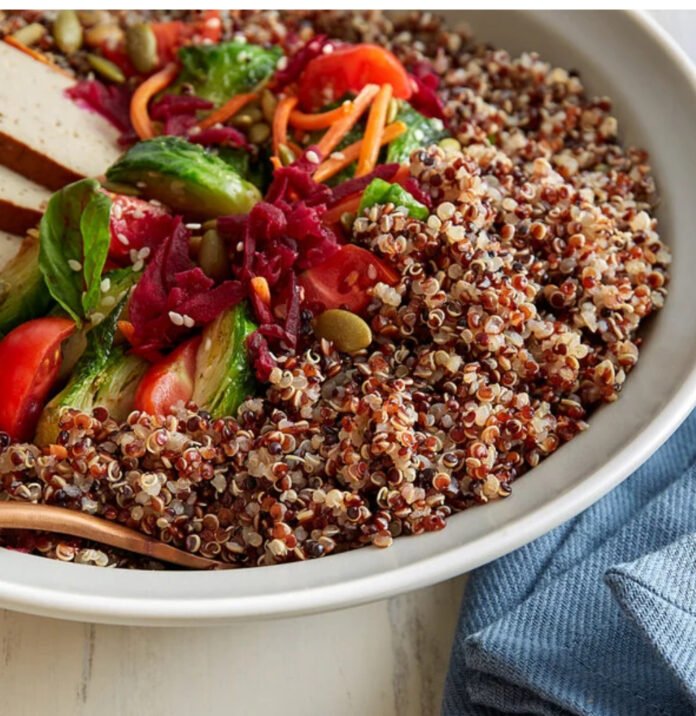What is Quinoa and Why is it Considered a Superfood?
Quinoa (Chenopodium quinoa) is a nutrient-rich grain that has increasingly gained recognition as a superfood over the past few decades. Originating from the Andean region of South America, quinoa was cultivated by the Incas over 5,000 years ago, who regarded it as a staple food and often referred to it as “the mother grain.” Its remarkable adaptability to various growing conditions and climates has contributed to its widespread availability and appreciation worldwide.
One of the distinguishing characteristics of quinoa is its status as a complete protein. Unlike many plant-based foods, quinoa contains all nine essential amino acids required for human health, making it an excellent source of protein for those following vegetarian or vegan diets. Additionally, quinoa is rich in dietary fiber, which aids digestion and helps regulate blood sugar levels, making it particularly beneficial for individuals managing diabetes.
Beyond its protein content, quinoa is packed with a variety of vitamins and minerals. This superfood offers significant amounts of magnesium, iron, potassium, and B vitamins, all of which are essential for maintaining overall health. Quinoa is also a rich source of antioxidants, compounds that help protect the body from oxidative stress and inflammation, further enhancing its health benefits.
Another noteworthy aspect of quinoa is its gluten-free nature, making it suitable for individuals with gluten sensitivities or celiac disease. This attribute, coupled with its versatility, allows quinoa to be seamlessly incorporated into a variety of dishes, from salads and soups to breakfast cereals and baked goods. Its nutty flavor and delightful texture make it an appealing substitute for rice or couscous, promoting a nutritious dietary choice.
Nutritional Profile of Quinoa and Its Impact on Health
Quinoa, often described as a superfood, boasts an impressive nutritional profile that can significantly contribute to overall health. This ancient grain is primarily composed of carbohydrates, which make up approximately 60% of its dry weight. However, quinoa’s carbohydrate content is unique, as it consists mainly of complex carbohydrates that are absorbed slowly, thereby providing a steady source of energy without causing dramatic spikes in blood sugar levels. This characteristic makes quinoa particularly beneficial for individuals managing diabetes.
In addition to its carbohydrate content, quinoa is an excellent source of plant-based protein, containing around 14% protein by weight. It is one of the few plant foods that is a complete protein, meaning it includes all nine essential amino acids necessary for human health. This quality makes quinoa an exceptional protein alternative for vegetarians and vegans, supporting muscle development and maintenance.
Furthermore, quinoa is rich in healthy fats, primarily unsaturated fats which are known for their heart-health benefits. These fats play a crucial role in maintaining cardiovascular health and reducing inflammation within the body. In terms of micronutrients, quinoa is abundant in essential vitamins and minerals such as magnesium, iron, and fiber. Magnesium aids in over 300 biochemical reactions, including the regulation of blood sugar levels and blood pressure. Iron is vital for transporting oxygen throughout the body, helping to prevent fatigue, while dietary fiber contributes to healthy digestion and the maintenance of a feeling of fullness, which can aid in weight management.
Overall, the consumption of quinoa can support multiple aspects of health, including metabolic function, improved digestion, and sustained energy levels. Incorporating this nutrient-dense superfood into a balanced diet can be a transformative step in promoting wellness, particularly for those dealing with diabetes.
Quinoa and Diabetes: A Perfect Match
Quinoa, often hailed as a superfood, has emerged as a valuable ally for individuals managing diabetes. This ancient grain is distinguished by its low glycemic index (GI) score, ranging from 53 to 69, which contributes to a slower and steadier release of glucose into the bloodstream. This characteristic is crucial for people with diabetes as it helps in maintaining stable blood sugar levels and preventing spikes after meals. Compared to traditional grains like white rice or bread, which typically have a high glycemic index, quinoa offers a healthier alternative, helping individuals make smarter dietary choices.
In addition to its favorable glycemic profile, quinoa’s rich fiber content plays a significant role in diabetes management. A single serving contains about 5 grams of dietary fiber, enhancing feelings of fullness and reducing overall calorie intake, which can be particularly beneficial for weight management—an essential component of diabetes care. Research indicates that individuals who consume high-fiber diets tend to exhibit improved blood sugar control and lower insulin resistance, significantly reducing the risk of developing type 2 diabetes.
Studies have shown that regular quinoa consumption may lead to better glycemic responses. One study linked whole grain intake, particularly quinoa, to improved fasting glucose levels and a decrease in HbA1c—an important marker for long-term blood sugar control. Furthermore, quinoa is rich in essential nutrients, including magnesium, which has been associated with a lower risk of type 2 diabetes. This element aids in glucose metabolism and enhances insulin sensitivity, providing further benefits for those managing the condition.
In summary, quinoa stands out as a remarkable food choice for individuals with diabetes, offering low glycemic index properties, high fiber content, and essential nutrients that collectively support better blood sugar management. Its integration into a balanced diet may prove advantageous for those aiming to manage their diabetes effectively.
Incorporating Quinoa into Your Diet: Tips and Recipe Ideas
Quinoa is a versatile grain packed with nutrients, making it an excellent addition to any diet, particularly for those managing diabetes. To begin incorporating quinoa into your meals, start by perfecting the cooking process. Rinse one cup of quinoa thoroughly under cold water to remove its natural coating, known as saponin, which can impart a bitter taste. Combine the rinsed quinoa with two cups of water or broth in a saucepan, bring the mixture to a boil, then reduce the heat and cover, allowing it to simmer for approximately 15 minutes until the quinoa is fluffy and the germ separates.
Once cooked, quinoa can be used in a variety of dishes. Consider introducing it into salads as a hearty base. For instance, a quinoa salad can consist of chopped vegetables, fresh herbs, and a light vinaigrette, creating a nutritious and satisfying meal. Additionally, it can be served as a side dish, replacing traditional grains like rice or couscous. A simple pilaf with sautéed onions, garlic, and your choice of spices can elevate any main course.
Quinoa is also great for making grain bowls; combine it with leafy greens, roasted vegetables, and a protein source such as beans or grilled chicken for a complete meal. For breakfast, try mixing cooked quinoa with almond milk, cinnamon, and a touch of honey for a warm, nutritious porridge topped with fruits and nuts. Even desserts can feature quinoa, such as in a quinoa pudding made with coconut milk and chia seeds, offering a unique sweet treat that aligns with a healthier lifestyle.
The key to successfully incorporating quinoa into your daily diet lies in its adaptability. By experimenting with different recipes and pairings, you will not only enjoy its delightful nutty flavor but also harness its significant health benefits, making quinoa a staple in your meals.





